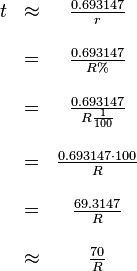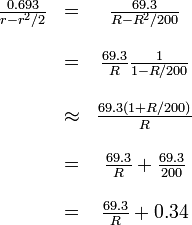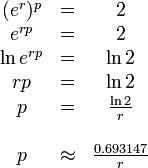Rule of 72
In finance, the rule of 72, the rule of 70 and the rule of 69.3 are methods for estimating an investment's doubling time. The rule number (e.g., 72) is divided by the interest percentage per period to obtain the approximate number of periods (usually years) required for doubling. Although scientific calculators and spreadsheet programs have functions to find the accurate doubling time, the rules are useful for mental calculations and when only a basic calculator is available.[1]
These rules apply to exponential growth and are therefore used for compound interest as opposed to simple interest calculations. They can also be used for decay to obtain a halving time. The choice of number is mostly a matter of preference: 69 is more accurate for continuous compounding, while 72 works well in common interest situations and is more easily divisible. There are a number of variations to the rules that improve accuracy. For periodic compounding, the exact doubling time for an interest rate of r per period is
 ,
,
where T is the number of periods required. The formula above can be used for more than calculating the doubling time. If one wants to know the tripling time, for example, simply replace the constant 2 in the numerator with 3. As another example, if one wants to know the number of periods it takes for the initial value to rise by 50%, replace the constant 2 with 1.5.
Using the rule to estimate compounding periods
To estimate the number of periods required to double an original investment, divide the most convenient "rule-quantity" by the expected growth rate, expressed as a percentage.
- For instance, if you were to invest $100 with compounding interest at a rate of 9% per annum, the rule of 72 gives 72/9 = 8 years required for the investment to be worth $200; an exact calculation gives ln(2)/ln(1+.09) = 8.0432 years.
Similarly, to determine the time it takes for the value of money to halve at a given rate, divide the rule quantity by that rate.
- To determine the time for money's buying power to halve, financiers simply divide the rule-quantity by the inflation rate. Thus at 3.5% inflation using the rule of 70, it should take approximately 70/3.5 = 20 years for the value of a unit of currency to halve.
- To estimate the impact of additional fees on financial policies (e.g., mutual fund fees and expenses, loading and expense charges on variable universal life insurance investment portfolios), divide 72 by the fee. For example, if the Universal Life policy charges a 3% fee over and above the cost of the underlying investment fund, then the total account value will be cut to 1/2 in 72 / 3 = 24 years, and then to just 1/4 the value in 48 years, compared to holding exactly the same investment outside the policy.
Choice of rule
The value 72 is a convenient choice of numerator, since it has many small divisors: 1, 2, 3, 4, 6, 8, 9, and 12. It provides a good approximation for annual compounding, and for compounding at typical rates (from 6% to 10%). The approximations are less accurate at higher interest rates.
For continuous compounding, 69 gives accurate results for any rate. This is because ln(2) is about 69.3%; see derivation below. Since daily compounding is close enough to continuous compounding, for most purposes 69, 69.3 or 70 are better than 72 for daily compounding. For lower annual rates than those above, 69.3 would also be more accurate than 72.
| Rate | Actual Years | Rule of 72 | Rule of 70 | Rule of 69.3 | 72 adjusted | E-M rule |
|---|---|---|---|---|---|---|
| 0.25% | 277.605 | 288.000 | 280.000 | 277.200 | 277.667 | 277.547 |
| 0.5% | 138.976 | 144.000 | 140.000 | 138.600 | 139.000 | 138.947 |
| 1% | 69.661 | 72.000 | 70.000 | 69.300 | 69.667 | 69.648 |
| 2% | 35.003 | 36.000 | 35.000 | 34.650 | 35.000 | 35.000 |
| 3% | 23.450 | 24.000 | 23.333 | 23.100 | 23.444 | 23.452 |
| 4% | 17.673 | 18.000 | 17.500 | 17.325 | 17.667 | 17.679 |
| 5% | 14.207 | 14.400 | 14.000 | 13.860 | 14.200 | 14.215 |
| 6% | 11.896 | 12.000 | 11.667 | 11.550 | 11.889 | 11.907 |
| 7% | 10.245 | 10.286 | 10.000 | 9.900 | 10.238 | 10.259 |
| 8% | 9.006 | 9.000 | 8.750 | 8.663 | 9.000 | 9.023 |
| 9% | 8.043 | 8.000 | 7.778 | 7.700 | 8.037 | 8.062 |
| 10% | 7.273 | 7.200 | 7.000 | 6.930 | 7.267 | 7.295 |
| 11% | 6.642 | 6.545 | 6.364 | 6.300 | 6.636 | 6.667 |
| 12% | 6.116 | 6.000 | 5.833 | 5.775 | 6.111 | 6.144 |
| 15% | 4.959 | 4.800 | 4.667 | 4.620 | 4.956 | 4.995 |
| 18% | 4.188 | 4.000 | 3.889 | 3.850 | 4.185 | 4.231 |
| 20% | 3.802 | 3.600 | 3.500 | 3.465 | 3.800 | 3.850 |
| 25% | 3.106 | 2.880 | 2.800 | 2.772 | 3.107 | 3.168 |
| 30% | 2.642 | 2.400 | 2.333 | 2.310 | 2.644 | 2.718 |
| 40% | 2.060 | 1.800 | 1.750 | 1.733 | 2.067 | 2.166 |
| 50% | 1.710 | 1.440 | 1.400 | 1.386 | 1.720 | 1.848 |
| 60% | 1.475 | 1.200 | 1.167 | 1.155 | 1.489 | 1.650 |
| 70% | 1.306 | 1.029 | 1.000 | 0.990 | 1.324 | 1.523 |
History
An early reference to the rule is in the Summa de arithmetica (Venice, 1494. Fol. 181, n. 44) of Luca Pacioli (1445–1514). He presents the rule in a discussion regarding the estimation of the doubling time of an investment, but does not derive or explain the rule, and it is thus assumed that the rule predates Pacioli by some time.
| “ | A voler sapere ogni quantita a tanto per 100 l'anno, in quanti anni sarà tornata doppia tra utile e capitale, tieni per regola 72, a mente, il quale sempre partirai per l'interesse, e quello che ne viene, in tanti anni sarà raddoppiato. Esempio: Quando l'interesse è a 6 per 100 l'anno, dico che si parta 72 per 6; ne vien 12, e in 12 anni sarà raddoppiato il capitale. (emphasis added). | ” |
Roughly translated:
| “ | In wanting to know of any capital, at a given yearly percentage, in how many years it will double adding the interest to the capital, keep as a rule [the number] 72 in mind, which you will always divide by the interest, and what results, in that many years it will be doubled. Example: When the interest is 6 percent per year, I say that one divides 72 by 6; 12 results, and in 12 years the capital will be doubled. | ” |
Adjustments for higher accuracy
For higher rates, a bigger numerator would be better (e.g., for 20%, using 76 to get 3.8 years would be only about 0.002 off, where using 72 to get 3.6 would be about 0.2 off). This is because, as above, the rule of 72 is only an approximation that is accurate for interest rates from 6% to 10%. Outside that range the error will vary from 2.4% to −14.0%. For every three percentage points away from 8% the value 72 could be adjusted by 1.
or for the same result, but simpler:
E-M rule
The Eckart–McHale second-order rule (the E-M rule) provides a multiplicative correction for the rule of 69.3 that is very accurate for rates from 0% to 20%. The rule of 69.3 is normally only accurate at the lowest end of interest rates, from 0% to about 5%. To compute the E-M approximation, simply multiply the rule of 69.3 result by 200/(200−r) as follows:
 .
.
For example, if the interest rate is 18%, the rule of 69.3 says t = 3.85 years. The E-M rule multiplies this by 200/(200−18), giving a doubling time of 4.23 years, where the actual doubling time at this rate is 4.19 years. (The E-M rule thus gives a closer approximation than the rule of 72.)
Note that the numerator here is simply 69.3 times 200. As long as the product stays constant, the factors can be modified arbitrarily. The E-M rule could thus be written also as
 or
or 
in order to keep the product mostly unchanged. In these variants, the multiplicative correction becomes 1 respectively for r=2 and r=8, the values for which the rule of 70 (respectively 72) is most precise.
Similarly, the third-order Padé approximant gives a more accurate answer over an even larger range of r, but it has a slightly more complicated formula:
 .
.
Derivation
Periodic compounding
For periodic compounding, future value is given by:
where  is the present value,
is the present value,  is the number of time periods, and
is the number of time periods, and  stands for the interest rate per time period.
stands for the interest rate per time period.
The future value is double the present value when the following condition is met:
This equation is easily solved for  :
:
If r is small, then ln(1 + r) approximately equals r (this is the first term in the Taylor series). Together with the approximation  , this gives:
, this gives:
which improves in accuracy as the compounding of interest becomes continuous (see derivation below).
However, humans tend to prefer performing mental calculations with percentages, so the formula is often restated as follows:
In order to derive the more precise adjustments presented above, it is noted that  is more closely approximated by
is more closely approximated by  (using the second term in the Taylor series).
(using the second term in the Taylor series).  can then be further simplified by Taylor approximations:
can then be further simplified by Taylor approximations:
Replacing the "R" in R/200 on the third line with 7.79 gives 72 on the numerator. This shows that the rule of 72 is most precise for periodically composed interests around 8%.
Alternatively, the E-M rule is obtained if the second-order Taylor approximation is used directly.
Continuous compounding
For continuous compounding, the derivation is simpler and yields a more accurate rule:
See also
References
- ↑ Slavin, Steve (1989). All the Math You'll Ever Need. John Wiley & Sons. pp. 153–154. ISBN 0-471-50636-2.
External links
- The Scales Of 70 – extends the rule of 72 beyond fixed-rate growth to variable rate compound growth including positive and negative rates.
- A note on the rule of 72 or how long it takes to double your money, The Investment Analysts Society of South Africa
- Rule of 72 Calculator, moneychimp.com
- Rule of 72 Learning Tool, directinvesting.com
- Financial Mathematics, ExcelExchange









